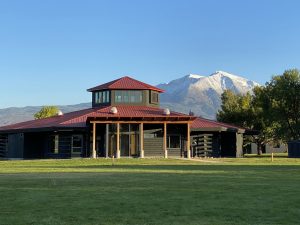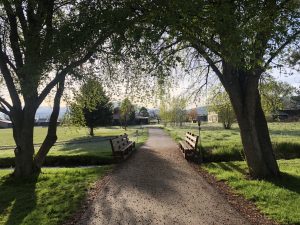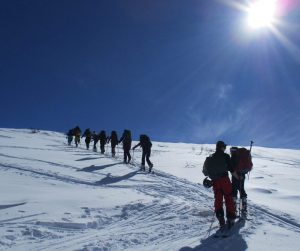Daily Lunch, Lifelong Habits
by Aimee Yllanes
except reprinted from Edible Aspen
Farm to table, directly
Since 2013, the USDA has also had a Farm to Schools program, granting funds to provide schools with local food. But it’s not just outside funding that makes local sourcing happen in Roaring Fork Valley schools. In fact, at Colorado Rocky Mountain School, the farm providing produce is run by the school itself and integrated into its curriculum.
“Our mission is a production garden,” says Heather McDermott, director of the CRMS garden program. “We produce a lot of food, and our customer is the dining hall. We feed students three meals a day, as well as the staff and community.”
The private boarding and day college-prep school sits on 300 acres straddling the Roaring Fork River. Part of that land—a historic ranch—has been converted into gardens, an effort that McDermott has ramped up in her six years at the helm. The gardens provide about 40 percent of the produce that the kitchen uses year-round, feeding roughly 200 people daily during the school year. “We can’t meet all their needs, but we take a big chunk out of it,” she says.
Last year, the school harvested 3,000 pounds of onions, which they were able to store in a root cellar and use throughout the year. Because there are fewer students on campus during the summer, when the produce starts to peak, McDermott has to balance growing preservable items with those that can be eaten during August, September, and October when there’s an abundance of food. Some vegetables and fruits can be frozen for use throughout the year, or made into sauces like pesto and marinara. In the summer, excess produce is donated to Lift-Up; this summer, more than 500 pounds of zucchini and cucumber were given to the food pantry.
Feeding the staff and students is important, but so is the process of learning how to grow food. CRMS students participate in a variety of service programs—many sign up for garden work. With an on-campus greenhouse, this engagement can happen throughout the school year, and it includes seeding and prepping for the school’s annual community spring plant sale, which nets $15,000 from growing and selling more than 8,000 plants. Additionally, the garden weaves into various curricula: Biology students study soil science and composting, health classes study nutrition, and photography students have an image treasure trove. “When you’re a part of the food that you’re eating—when you’re outside digging potatoes and the next day you turn around and eat them—you have a greater appreciation for the food,” says Stella Guy Warren, a senior at CRMS.
Even though Guy Warren is a day student and Carbondale resident, she eats lunch every day on campus and often dinner too. “I think it’s easy to not know where your food is coming from and just show up to eat,” she says.
Guy Warren’s appreciation is palpable, but not every student develops that while at school.
“Students who have gone here then go on to come back and say, ‘This is where I started gardening,’” says McDermott. “It is a more mature thing. But let’s get kids to try to get this concept early instead of only appreciating once they leave.”
… food and nutrition awareness is key. Yes, eating healthy is paramount and has immediate effects on kids’ learning habits. But creating healthy habits for a lifetime is the long-term goal.
Smiles, thank yous, and second helpings are all tokens of encouragement. But the greatest satisfaction comes in knowing that students are well fed—with real food.
Garden, Service, Wellness
 MYCRMS
MYCRMS





 Virtual Tour
Virtual Tour

